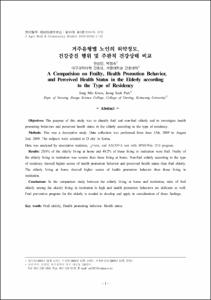거주유형별 노인의 허약정도, 건강증진 행위 및 주관적 건강상태 비교
- Keimyung Author(s)
- Park, Jeong Sook
- Department
- Dept. of Nursing (간호학)
- Journal Title
- 농촌의학·지역보건
- Issued Date
- 2010
- Volume
- 35
- Issue
- 1
- Abstract
- Objectives: The purpose of this study was to classify frail and non-frail elderly and to investigate health
promoting behaviors and perceived health status in the elderly according to the type of residency.
Methods: This was a descriptive study. Data collection was performed from June 15th, 2009 to August
2nd, 2009. The subjects were selected at D city in Korea.
Data was analyzed by descriptive statistics, x 2-test, and ANCOVA test with SPSS/Win 15.0 program.
Results: 20.8% of the elderly living at home and 49.2% of those living in institution were frail. Frailty of
the elderly living in institution was severer than those living at home. Non-frail elderly according to the type
of residency showed higher scores of health promotion behavior and perceived health status than frail elderly.
The elderly living at home showed higher scores of health promotion behavior than those living in
institution.
Conclusions: In the comparison study between the elderly living at home and institution, ratio of frail
elderly among the elderly living in institution is high and health promotion behaviors are deficient as well.
Frail preventive program for the elderly is needed to develop and apply in consideration of these findings.
Key words: Frail elderly, Health promoting behavior, Health status
본 연구는 재가노인과 시설거주노인의 허약노인 비율, 허약정도, 건강증진행위 및 주관적 건강상태를 비교하여, 거주유형에 따른 허약노인의 특성을 고려한 건강관리전략을 수립하는데 기여 하고자 실시한 서술적 조사연구이다. 연구대상자는 65세 이상의 D광역시에 소재한 7개 노인정을 이용하는 재가노인 120명과 5개 무료 및 실비 요양 시설에 거주하고 있는 시설거주노인 122명 총 242명을 대상으로 2009년 6월 15일부터 8월 2일까지 자료를 수집하였다. 연구도구로는 허약노인선정도구로서 장기요양보험제도에서 사용하는 기초측정표 설문지, Walker 등[18]이 개발한 건강증진생활양식 측정도구를 기반으로 한 건강증진 행위 측정도구, Lawston 등[19]이 개발한 주관적 건강상태 측정도구를 사용하여 측정하였다. 수집 된 자료는 SPSS Win 15.0을 이용하여 빈도와 백분율, $x^2$ 수식 이미지-test, ANCOVA, Scheffe 사후검증으로 분석하였다. 본 연구의 결과는 다음과 같다. 첫째, 재가노인 중 허약노인은 20.8%, 시설거주노인 중 허약노인은 49.2%로 나타났다. 둘째, 시설거주노인의 허약정도는 9.41점으로 재가노인은 6.46점보다 더 심한 것으로 나타났다(p<.05). 재가노인의 건강증진행위점수는 2.12점으로 시설거주노인의 1.99점보다 높았으며(p=0.046), 건강증진행위 하위항목별로 보면 재가노인의 영적성장(p=.008)과 대인관계(p=.043)점수가 시설거주노인보다 높았다. 주관적 건강상태는 재가노인과 시설거주노인 간에 차이가 없었다. 셋째, 허약노인과 비허약노인의 거주유형별 허약정도를 보면, 재가 허약노인과 시설거주 허약노인이 비허약노인보다 허약정도가 심하고, 비허약노인 중에서는 시설거주 비허약노인이 재가 비허약노인보다 허약정도가 심한 것으로 나타났다(p<.05). 건강증진행위점수는 재가 비허약노인과 시설거주 비허약노인이 허약노인보다 높았고, 허약노인 중에서는 재가 허약노인은 시설거주 허약노인보다 높은 것으로 나타났다(p<.05). 주관적 건강상태점수는 시설거주 비허약노인과 재가 비허약노인이 허약노인보다 높았고, 허약노인 중에서는 시설거주 허약노인이 재가 허약노인보다 높았다(p<.05). 결론적으로 재가노인과 시설거주노인을 비교해 보았을 때, 시설거주노인 중에서 허약노인의 비율이 높고 시설거주노인의 건강증진행위 수행이 부족하므로 이런 특성을 반영하여 거주유형에 따른 노인 허약예방프로그램의 개발과 적용이 필요하다.
- Alternative Title
- A Comparision on Frailty, Health Promotion Behavior, and Perceived Health Status in the Elderly according to the Type of Residency
- Keimyung Author(s)(Kor)
- 박정숙
- Publisher
- College of Nursing
- Citation
- 권상민 and 박정숙. (2010). 거주유형별 노인의 허약정도, 건강증진 행위 및 주관적 건강상태 비교. 농촌의학·지역보건, 35(1), 1–12. doi: 10.5393/JAMCH.2010.35.1.001
- Type
- Article
- ISSN
- 1738-9577
- Appears in Collections:
- 2. College of Nursing (간호대학) > Dept. of Nursing (간호학)
- 파일 목록
-
-
Download
 oak-bbb-00252.pdf
기타 데이터 / 791.61 kB / Adobe PDF
oak-bbb-00252.pdf
기타 데이터 / 791.61 kB / Adobe PDF
-
Items in Repository are protected by copyright, with all rights reserved, unless otherwise indicated.